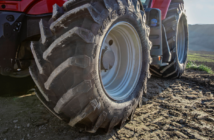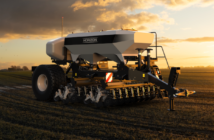York-based Wharram and Kay have been impressed with Michelin’s latest generation of its EvoBib tyres after fitting them to a new Fendt 728 tractor.
The EvoBib is said to be the first agricultural tyre on the market specifically designed to be used with Central Tyre Inflation Systems (CTIS), allowing it to obtain excellent performance on the road and in the field due to its adaptive design.
After receiving a SIMA gold medal for innovation when it was first launched in 2017, Michelin introduced a new and improved version of the range last year – offering farmers an ideal ‘2-in-1’ solution.
Wharram and Kay co-owner, Roger Kay, said: “We were first introduced to the EvoBib several years ago and have used them ever since. For seed drilling operations, I believe it is simply the best tyre out there because of the way it can spread the tractor’s weight across the ground and how kind it is on the soil.”
The new EvoBib offers a footprint variation of 47% between road and field, double that of a VF tyre such as the AxioBib 2 that would have usually been used with a CTIS. The tread design has also been adapted to improve longevity and offer excellent traction capabilities until the end of the tyre’s life.
Additionally, in the new EvoBib the tyre casing is now PFO (Pressure Field Operation) rated, a standard that allows manufacturers to increase the load capacity of their tyres for field use.
Wharram and Kay had the original equipment fitments on its new Fendt replaced with Michelin EvoBibs by its local dealer Tanvic Farm Tyres. It will be used predominantly for seed drilling work in the field, and pulling trailers and machinery from job to job while out on the road.
“The Fendt has a VarioGrip CTIS onboard which inflates and deflates the tyres accordingly,” added Mr Kay. “We’re looking forward to seeing the impact of this latest version of the EvoBib. On the ones we have used previously there was a massive difference in the contact area on the ground with other VF tyres we’d used, which is so important.
“They alleviate any soil compaction which meant that the crop emergence was very uniform, there was no delay in emergence behind the tractor wheelings, for instance, which we had experienced.”




